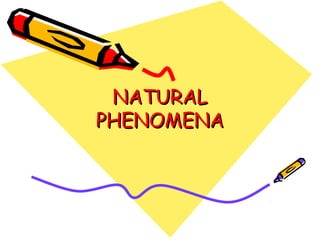
Natural phenomena
- 2. Movement of electrons through a conductor is called electricity. Electricity used in electrical appliances is called current electricity. It flows through wires. Electricity which does not flow is called static electricity.
- 3. Benjamin Franklin was an American scientist who did his well known kite experiment in the year 1749. He performed his experiment by using a kite made of silk to which a small metallic key was attached. He flew the kite into the clouds and waited for lightning to strike.
- 4. When lightning struck, the key was found to have become hot. The key was also found to have got electrically charged. Franklin concluded that the thunder clouds must be electrically charged.
- 5. Thus, in a way, in his experiment he had drawn the electricity of the atmosphere into the key. He also demonstrated directly that lightning is associated with electricity.
- 6. Dr.Gilbert showed that amber rubbing with cat’s skin and glass rod rubbing with silk, it develops a properties of attracting tiny bits of dry paper, dry straw and also develops similar properties when rubbed against each other.
- 7. When two such objects are rubbed together and separated, they both acquire the property of attracting light objects. we call such objects having this property, to attract or repel as charged objects. Any object which does not have this ability is referred to as an uncharged objects.
- 8. The process of charging up an object is referred to as electrification. Therefore, Thales may be regarded as having discovered that “electricity can be produced by rubbing or by friction”.
- 9. A charged comb (rubbed against your dry hair) can attract small pieces of dry paper. A charged pen (rubbed against a dry cotton T-shirt) can attract tiny bits of dry paper. A charged plastic board (rubbed against woollen cloth ) attracts popcorns.
- 10. Benjamin Franklin found that there are two kinds of electrical charges, A) Positive (+ve) B) Negative (-ve) Like Charges repel each other unlike charges attract each other.
- 11. Two charged ebonite rods repel each other. Two charged glass rods repel each other. A charged ebonite rod and a charged glass rod attract each other.
- 12. Thunder is what you hear, lightning is what you see, but both are due to electrical discharge in the atmosphere.
- 13. They can seem to be separated in time to an observer (you see the lightening before you hear the thunder) because of the large difference in the speed of sound and the speed of light.
- 14. If you are significant distance away (a few miles or kilometers), the light from the discharge will reach you almost instantly, but the sound can take several seconds to arrive.
- 15. In fact you can measure the distance from you to the lightening in this way: for each second delay between seeing it and hearing it, the lightening bolt is approximately 300 meters, or 1000 ft away.
- 16. Sequence of steps are responsible for these natural phenomena. a) The +ve & -Ve charges present in thunder cloud get separated. This separation occurs in a way that is similar to the separation that occurs due to the rubbing of one object against other.
- 17. The +ve charge move to the upper edge of the cloud & the –ve charge move to the lower edge of the cloud. B) Because of this collection of –ve charges near the bottom of the cloud, the earth becomes +ve charged with respect to the cloud by a potential of the order of as much as 100 million volts.
- 18. c) This difference between the cloud and earth ’breaks’ the air into + & -ve charges or ions. d) The huge –ve charges present near the bottom of the clouds flows through the conducting air down towards the earth. If any tree or building comes in the path of this flowing current, this object gets burnt or seriously damaged. Then we say that lightning has struck the object.
- 19. F) The lightning stroke through the air, heats it to a very high temperature. In fact, the air then momentarily acquires temperature as high as 30,000 c. This rapid heating followed by a very rapid cooling of air produces a shock wave in it. It is this which results in a thundering sound.
- 22. Lightning is the result of the flow of large amount of charges between two (oppositely charged) clouds or a cloud and the earth. A huge amount of electrical energy get discharged during this flow. This heat up the air to very high temperatures.
- 23. This, in turn, produces the flashes of lightning that we see in the sky and accompanying thundering sound. It has been estimated that if this interval is 30 seconds or less, ’the lightning’ can pose a serious danger to the area where it occurs.
- 24. It has also been suggested that one should continue to stay in one’s shelter for almost 30 minutes after observing the last flash of lightning. This is sometimes referred to as the the 30-30 principle of safety against Lightning.
- 27. A metallic conductor fixed on high rise buildings to protect them from lightning by conducting the atmospheric electricity into the earth. The lower end of the metal is connected to a large copper plate which is buried inside the earth is called earthing.
